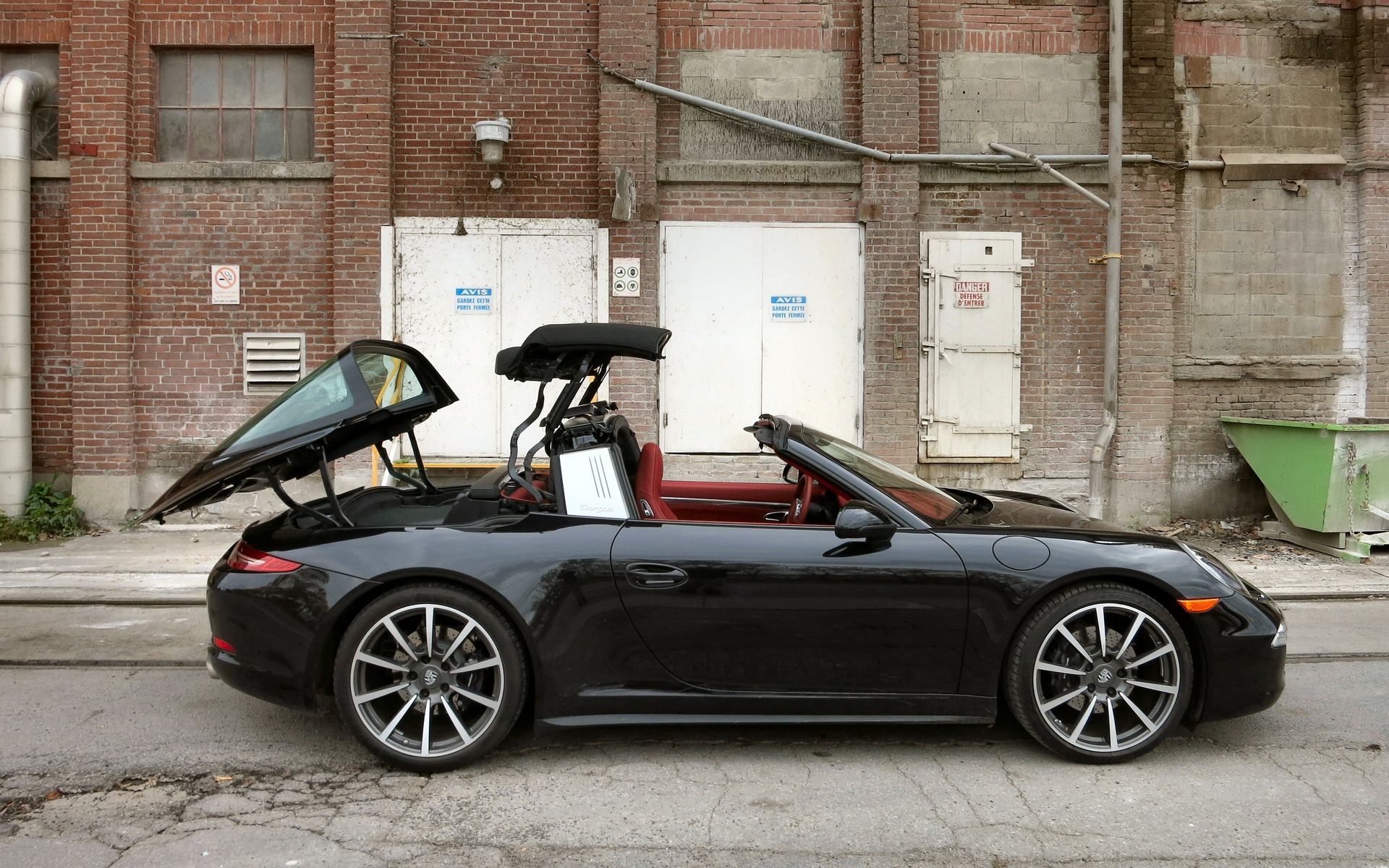2015 Porsche 911 Targa 4: Stuttgart's Sixties Buzzcut


The 2015 Porsche 911 Targa 4 is proof that infinite variation on a theme can serve as a viable business strategy in the sports car universe. Simultaneously tapping retro-themed styling and gee-whiz technological wizardry, the 911 Targa 4 is wedged between the 911 coupe and the open-air 911 Cabriolet, giving Porsche fans on the fence a compromise between top-down fun and day-to-day practicality. It also delivers a styling boost to a model where a philosophy of evolution rather than revolution has made it the elder statesman of design in its class.
Topless Show-Stopper
In a society that has become so normalized to the ubiquitous automotive pornography that populates the $100k-and-up price range, how you decide to take off your top is now far more interesting than whether you elect to do it or not. The 2015 Porsche 911 Targa 4 raises the bar – or should I say pole? – by way of its trick roof mechanism. Most targa-style sports cars, including the current Corvette Stingray and past editions of the 911 (the Targa model was introduced in 1965 and ran until the mid-90s) simply ask owners to pop off a fibreglass or cloth panel and stow it in the garage. The new Targa 4 eliminates the human element by way of a complex system that raises the entire rear hatch, balances it near-vertically over the 911’s hindquarters, and then folds the cloth top into a storage cubby just ahead of the rear-mounted engine.
Read also
The entire process takes roughly 19 seconds and requires the vehicle to be completely immobile – an eternity at a stoplight – but that doesn’t matter, since everyone within a 30 metre radius will be gawking, completely distracted, at the awkward glory of the Targa Show. Once the roof is out of view and the car has re-assembled itself they’ll still be staring, but this time for a different reason. The 911 Targa 4’s silver roll hoop, with its chrome ‘targa’ script and gill slits, is evocative of the original Targa’s classic design and has proven to be a real winner for Porsche in further distinguishing the 911’s familiar shape from other variants of the vehicle.
Why Targa?
There are both trade-offs and advantages to the 2015 Porsche 911 Targa 4’s unique approach to open air motoring. In addition to its eye-catching styling, Porsche promises that the Targa 4 features a marginally stiffer chassis when compared to the full-on Cabriolet – although it’s still half as resistant to flex as the traditional 911 coupe. Unfortunately, the presence of the Targa hoop and bulbous rear glass creates wind buffeting that’s not present in the flow-through Cab, an issue that Porsche has attempted to mitigate by way of a two-position wind deflector at the top of the windshield. There’s also the occasional squeak or rattle of the movable hatch panel when travelling over rough pavement with the Targa top in the open position.
Not Quite As Focused
Most convertible sports cars aren’t as tight as their fixed-roof counterparts when it comes time to get serious about handling, and the Porsche 911 Targa 4 is no exception. I’ve already mentioned the less rigid structure of the Targa 4, but there’s also the question of weight. Specifically, despite its best efforts to keep the roof’s mechanical bits as light as possible, there’s still about 100 kilograms of extra Stuttgart-sourced mass to account for in the Porsche compared to the base 911 coupe, including the added heft of the car’s standard all-wheel drive system.
The portlier personality of the Targa 4 manifests itself in two ways: first through the corners, where turn-in and steering feel are excellent but the car’s more burdened suspension is evident, and off the line, where the 3.4-litre six-cylinder engine’s 350 horsepower and 287 lb-ft of torque require 5.2 seconds to propel the car to 100 km/h when matched with the included seven-speed manual gearbox (a quicker-shifting seven-speed PDK automated manual is optional). If you want a bit more grunt, then the Targa 4S and its 400 horse, 3.8-litre engine can be snagged from the upgrade list.
Don’t get me wrong: the Porsche 911 Targa 4 is still a capable car that puts in a respectable performance in the absence of comparison to its fixed-roof sibling. Throw the 911 coupe into the mix, however, and it becomes clear that the Targa 4 is best suited for cruising and grand touring purposes rather than track duty.
A Horse For Every Course
And really, is there anything wrong with that? Personally, I don’t think there is. If you are willing to pay a near-$15,000 premium for the not-quite-convertible Targa 4 and its attention-grabbing neo-classic styling, then enjoy it in good health. Who says you need the stiffest, most precise, and quickest Porsche on the planet to have a blast driving under the fall foliage or sampling the stars from the cockpit of your 911? As the old saying goes, find your niche and you’ll never work a day in your life. As the feel-good, nostalgia-laden member of the 911 family, the Targa 4 wont be punching the clock anytime soon.








